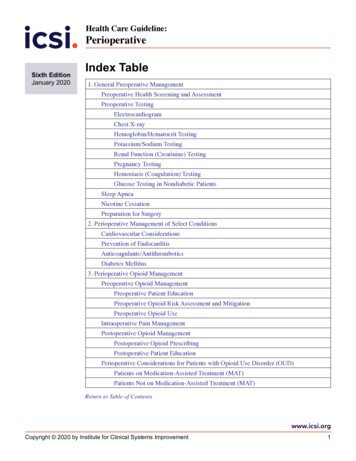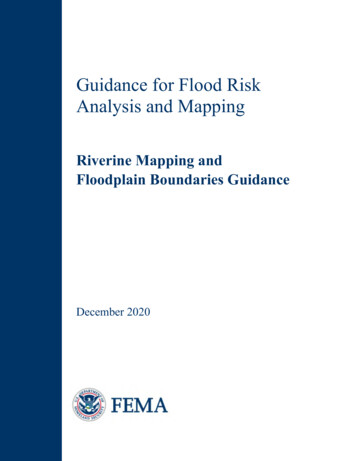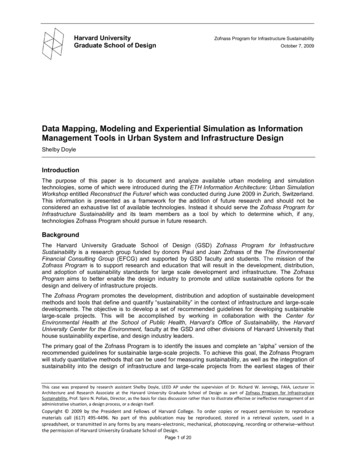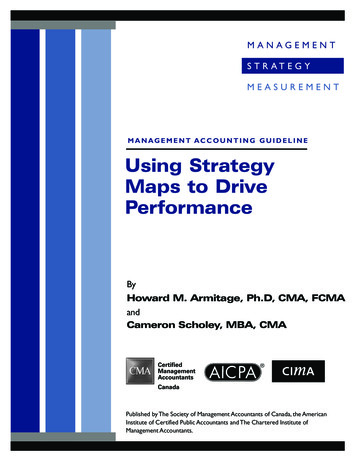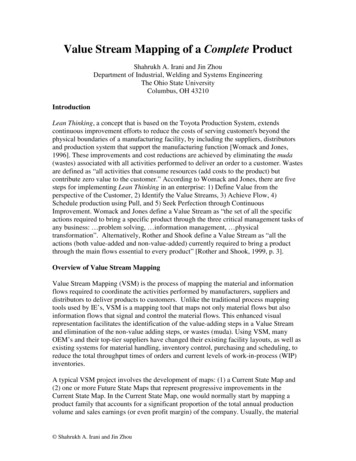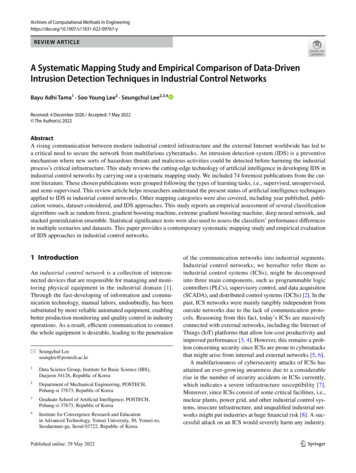
Transcription
Archives of Computational Methods in 7-yREVIEW ARTICLEA Systematic Mapping Study and Empirical Comparison of Data‑DrivenIntrusion Detection Techniques in Industrial Control NetworksBayu Adhi Tama1 · Soo Young Lee2 · Seungchul Lee2,3,4Received: 4 December 2020 / Accepted: 7 May 2022 The Author(s) 2022AbstractA rising communication between modern industrial control infrastructure and the external Internet worldwide has led toa critical need to secure the network from multifarious cyberattacks. An intrusion detection system (IDS) is a preventivemechanism where new sorts of hazardous threats and malicious activities could be detected before harming the industrialprocess’s critical infrastructure. This study reviews the cutting-edge technology of artificial intelligence in developing IDS inindustrial control networks by carrying out a systematic mapping study. We included 74 foremost publications from the current literature. These chosen publications were grouped following the types of learning tasks, i.e., supervised, unsupervised,and semi-supervised. This review article helps researchers understand the present status of artificial intelligence techniquesapplied to IDS in industrial control networks. Other mapping categories were also covered, including year published, publication venues, dataset considered, and IDS approaches. This study reports an empirical assessment of several classificationalgorithms such as random forest, gradient boosting machine, extreme gradient boosting machine, deep neural network, andstacked generalization ensemble. Statistical significance tests were also used to assess the classifiers’ performance differencesin multiple scenarios and datasets. This paper provides a contemporary systematic mapping study and empirical evaluationof IDS approaches in industrial control networks.1 IntroductionAn industrial control network is a collection of interconnected devices that are responsible for managing and monitoring physical equipment in the industrial domain [1].Through the fast-developing of information and communication technology, manual labors, undoubtedly, has beensubstituted by more reliable automated equipment, enablingbetter production monitoring and quality control in industryoperations. As a result, efficient communication to connectthe whole equipment is desirable, leading to the penetration* Seungchul Leeseunglee@postech.ac.kr1Data Science Group, Institute for Basic Science (IBS),Daejeon 34126, Republic of Korea2Department of Mechanical Engineering, POSTECH,Pohang‑si 37673, Republic of Korea3Graduate School of Artificial Intelligence, POSTECH,Pohang‑si 37673, Republic of Korea4Institute for Convergence Research and Educationin Advanced Technology, Yonsei University, 50, Yonsei‑ro,Seodaemun‑gu, Seoul 03722, Republic of Koreaof the communication networks into industrial segments.Industrial control networks; we hereafter refer them asindustrial control systems (ICSs), might be decomposedinto three main components, such as programmable logiccontrollers (PLCs), supervisory control, and data acquisition(SCADA), and distributed control systems (DCSs) [2]. In thepast, ICS networks were mainly tangibly independent fromoutside networks due to the lack of communication protocols. Reasoning from this fact, today’s ICSs are massivelyconnected with external networks, including the Internet ofThings (IoT) platforms that allow low-cost productivity andimproved performance [3, 4]. However, this remains a problem concerning security since ICSs are prone to cyberattacksthat might arise from internal and external networks [5, 6].A multifariousness of cybersecurity attacks of ICSs hasattained an ever-growing awareness due to a considerablerise in the number of security accidents in ICSs currently,which indicates a severe infrastructure susceptibility [7].Moreover, since ICSs consist of some critical facilities, i.e.,nuclear plants, power grid, and other industrial control systems, insecure infrastructure, and unqualified industrial networks might put industries at huge financial risk [8]. A successful attack on an ICS would severely harm any industry.13Vol.:(0123456789)
B. A. Tama et al.Negative consequences include financial loss, operationalfailure, damaged equipment, industrial property piracy, andsignificant safety risk. The configuration and scale of an ICSwill determine whether or not it has faults. The larger thesystem, the bigger the chance for attackers to exploit. AnICS that installs its former system with advanced tools, e.g.,Industrial Internet of Things (IIoT), might have more specific threats and security risks. Hence, security protectionand mitigation strategies of the relevant ICSs are a must [9].A strategy for addressing the issues mentioned aboveis to develop intrusion detection systems (IDSs). An IDSincludes one of the prevention mechanisms used to eliminateunauthorized activities within a system network due to ICSssoftware vulnerabilities. It aims at detecting and intercepting the attacks automatically by analyzing network and fileaccess logs, audit trails, and other relevant information ina computer system [10, 11]. Since the earliest IDS conceptintroduced by Anderson [12], there has been a considerable increase in research interest to implement intrusiondetection technology for ICSs. Artificial intelligence (AI)techniques, e.g., machine learning and deep learning algorithms, have been utilized to ameliorate the performance ofIDSs [13]. Sort of IIoT devices might produce large amountsof data from a sensor, machine-to-machine (M2M) communication, and automation. This paradigm has shifted theresearch direction from a traditional data analysis using shallow machine learning (ML) to a big data analysis using deeplearning (DL) techniques [14].In addition, because of the ever-increasing complexity of ICSs, the conventional intrusion detection systemsin the information technology domain are not fit to industrial process [15], it thus has rendered DL-based intrusiondetection techniques fascinating. This study presents a systematic review of state-of-the-art artificial intelligence techniques used for intrusion detection/prevention in ICSs. Thestudy has been extended to include DL algorithms, such asdeep neural network (DNN), convolutional neural network(CNN), and recurrent neural network (RNN), providingresearchers and practitioners an insight into the current status and future trends of IDSs literature adopted in the ICSsenvironment.The remainder of the paper is structured as follows. Section 2 discusses the basic concepts of industrial control andintrusion detection systems. Section 3 substantiates thecurrent research by comparing it to several similar surveystudies, whereas Sect. 4 details the mapping study methodology. Section 5 summarizes and explains the results fromthe mapping study for each category. Section 6 examinesseveral methods for implementing IDSs in ICSs, followedby Sect. 7, which includes the concluding observations anddiscusses the future research directions.2 Background2.1 Industrial Control SystemsAn ICS can be viewed as interconnected devices, systems,networks, and controls utilized to automatize industrial processes [16]. Each ICS operates in several ways to handlethe tasks depending on the type of industry efficiently. Thedevices and protocols in an ICS are utilized as the backbone in almost all industrial sectors and major facilities,providing infrastructures for electricity generation and distribution, water treatment and supply, manufacturing, andtransportation.ICSs lay down in several variants, more typical of whichare SCADA, DCSs, and PLCs. Nevertheless, the contrastsand boundaries between these categories are not consistentlyfigured out. Determining apparent differences can be no lessstrict due to the advancement of technologies used by thesecategories. SCADA systems are primarily employed for theacquisition and processing of a large amount of data andcontrol industrial equipment by establishing remote commands [1, 18]. DCSs consist of multiple local controllersthat are managed by a centralized supervisory control loop.PLCs are digital computer apparatus that takes inputs fromdata generation means, e.g., sensors, transmit them to thewhole production units, and provide the outputs throughhuman-machine interfaces.Fig. 1 A multi-level ICSs architecture [17]13
A Systematic Mapping Study and Empirical Comparison of Data‑Driven Intrusion Detection An ICS is composed of multi-level architecture (seeFig. 1). Level 0 forms the system’s front-line, where industrial physical components and their related instrumentationare organized. The devices can be actuators and sensors thatinvolve in performing diagnostic operations and communicating with other components. The aim of Level 1 is tocontrol and manage the industrial process using controllerdevices, e.g., PLCs. Concerning structure, PLCs are composed of some computing devices, i.e., CPU, RAM, input/output modules, and communication interfaces that allowreal-time communication with sensors and actuators [19].Level 2 involves some control servers responsible for collecting information from the lower layers used to monitorand diagnostic purposes. Next, the collected information ispresented to the operators via a human-machine interface(HMI), a graphical indicator that provides the physical process’s circumstance. Lastly, Level 3-4 incorporates the allocation and optimization resources, maintenance planning,and quality control. These actions are planned based on theinformation collected from the previous stages.As compared to prevalent information technology (IT)systems, ICSs have some specific characteristics that must betaken into consideration. Some primary differences shouldnot be omitted while considering security measures withinindustrial control ecosystem. Table 1 outlines some key distinctions between conventional IT systems and ICSs [1, 16,20].2.2 Intrusion Detection SystemsAn intrusion detection system is a responsive security mechanism used to monitor the network security status by detecting external aggression and anomalous servers’ operations.It aims at providing credible traces of information systemsbeing intruded. Concerning the detection approach, an IDSmight have two distinct categories, i.e., anomaly-basedand misuse-based. The former approaches assume that anintruder can be detected by inspecting deviations from theregular network traffic. An advantage of these approachesincludes the ability to detect unacknowledged attacks; however, they remain to suffer from a considerable amount offalse alarm rate [22–24]. On the other hand, the latter [25]works based on some known attack signatures, in which apossible attack is analyzed and detected by comparing itwith such pre-defined attack signatures provided by a knowledge base of attack. A pattern-matching approach is commonly utilized in the suspicious detection task. In contrastto anomaly-based IDSs, misuse-based IDSs generate a lowerfalse alarm rate, yet, unknown attack detection is lacking.Additionally, IDSs can be classified into two primarydeployment types, namely host-based and network-based.The primary objective of host-based intrusion detectionsystems (HIDSs) is to monitor and then notify about occurrences on a local computer system. A hash of the file systemis one example found in HIDS. Untrustworthy behavior isidentified by comparing the differences between the recalculated hash value and the previously saved in the database. Onthe other hand, network-based intrusion detection systems(NIDS) are intended to monitor network traffic and detectmalicious activity by examining inbound network packets.To summarize, Fig. 2 illustrates the breadth of IDSs discussed in [21].3 Problem Definition and MotivationMost previous research concentrates on machine learning, deep learning, and intrusion detection in industrialcontrol systems. Some surveys have either emphasizedmachine learning algorithms [26–29], intrusion detectionTable 1 The distinctions between conventional IT systems and ICSsCategoryConventional IT systemsIndustrial control systemsPerformance and timelinessResponse time is less critical, jitter is onlyessential in VoIPLess importantAbundant3-5 yearsData confidentiality and integrityTypicalStandardLocal and easy to accessDiverseTimely fashion, or automatedPersonCentralized to lower operational costsEncryption algorithmReal-time and deterministicAvailabilityResource constraintsComponent lifetimeRisk managementSystem operationCommunicationsComponent locationManaged supportChange managementUserNature of systemSecurity focusHigh degree, i.e. unpredictable failure is intolerableLimited to specific embedded devices such as controllers15–20 yearsHuman safety and regulatory complianceProprietaryProprietaryIsolated and remoteSingle vendorThorough test, outage is plannedComputer or highly intelligent control deviceDistributed to insure reliability and availabilityVPN security13
B. A. Tama et al.Fig. 2 Taxonomy of intrusion detection system proposed by [21]in ICSs [30], or particular IDS approach, e.g. anomaly detection [31]. Moreover, most of the survey frameworks are notderived from a systematic review of existing research. Therefore, the coverage and meaningfulness of the frameworksremain insignificant. As far as we can tell, no studies havesystematically surveyed the feasibility of utilizing machinelearning and deep learning techniques in the purview ofintrusion detection in ICSs. Table 2 presents some of theprior applicable reviews and emphasizes the research gaps.We conduct a systematic mapping study and empiricalevaluation focusing on the present literature on intrusiondetection in ICSs using machine learning and deep learningtechniques to bridge the research gap. A systematic mapping study was initially proposed by [32, 33]. It is a researchmethodology whose objective is to bring a thorough overview of a field of interest, characterize the research gap,and establish some remarks for future research directions.13Utilizing this procedure, we categorize machine learning anddeep learning-based IDSs techniques applied in ICSs, showfrequencies of publications, combine the results to answersome detailed research questions, and present a visual summary by mapping the results.This study fosters the existing literature towards providing state-of-the-art information about implementing machinelearning and deep learning techniques for intrusion detection in the industrial control network. We argue that thissystematic mapping study will allow researchers or professionals to formulate more proper machine or deep learningbased IDS techniques. Besides, this study is not a cure-allfor solving the research challenges in intrusion detection forICSs; however, this would be a significant outset to developadvancement in employing machine learning and deep learning-based IDS in an industrial control environment.
The usage of deep learning and empiricalevaluation were not discussed.Deep learning techniques and empiricalevaluation were underexplored.Deep learning techniques and empiricalevaluation were underexplored.Discussion on deep learning has beenpresentedDeep learning algorithms are primarilyincludedThe study has not included any deep learning techniques[26]To provide the use of machine learning onintrusion detection in ICSsThe authors summarize previous work forIDSs approaches in industrial controlsystemsExisting IDS algorithms as well as the software used are studied[29][28]A new taxonomy of IDS for industrial control is provided[27][31]A taxonomy and a set of metrics forSCADA-specific intrusion detection techniques have been presentedThe authors have provided a roadmap ofanomaly detection in industrial networksThis section describes the steps involved in performing asystematic mapping study. It follows the criteria for conducting secondary research proposed by [32] and [34]. Althoughquality evaluation is required for any systematic review [34],in our mapping study, a quality assessment to filter outmain studies is not deemed essential since we structure ouranalysis to be as broad as feasible. Following the recommendations, we specify the research questions (RQs) beingaddressed, the search method, and the selection (e.g., inclusion) procedure of primary studies in the following sections.4.1 Research QuestionsThe authors have not discussed deep learningThe authors have not discussed deep learningMachine learning and deep learning usedfor IDS in industrial control network arepresentedThe use of deep learning is includedMisuse detection, ML and DL algorithms,and empirical evaluation were underexplored.Machine learning and deep learning techniquesAn extensive discussion about machinelearning and deep learning for IDS inindustrial control networkBoth misuse and anomaly detection forindustrial networks are discussedMachine learning and deep learning algorithms have not been discussed[30]IDS techniques, machine learning, anddeep learning algorithms have not beenincluded. Specific to anomaly detectionmachine learning and deep learning algorithms have not been discussedImportance of our studyConstraintsML and DL techniques and empirical evaluation were underexplored.4 Procedure of Mapping StudyStudy PurposeTable 2 Summary of previous surveys applicable to machine learning and deep learning for intrusion detection in ICSsResearch gapA Systematic Mapping Study and Empirical Comparison of Data‑Driven Intrusion Detection As noted by [34], RQs should manifest the objective of secondary studies. RQs also specify the issue to be investigatedand direct to the methodology [35]. Hence, the aim andscope of this study are formulated using the following RQs.The first-three RQs would be addressed in Sect. 5, while therest RQ is covered in Sect. 6.(i) RQ1: What is the research trend in machine learningand deep learning-based intrusion detection in ICSs?(ii) RQ2 : What types of learning algorithms have beenemployed to deal with the problems of IDSs in industrial networks?(iii) RQ3: Which types of intrusion detection techniquesare prevalently used in ICSs?(iv) RQ4 : What are the relative performance of AI algorithms for ICS-based IDS?4.2 Search MethodDespite the fact that machine learning algorithms have beeneverywhere for more than four decades, however, there existseveral issues remain underexplored, leading to a significantincrease of interest in utilizing those algorithms to solvereal-world problems. As already noted, some elementsaffecting this flourishing attention for AI are along the following axes: (i) the price of computational resources aredepreciating, (ii) the advancement of powerful and efficientalgorithms that are able to tackle different forms of data, and(iii) a vast amount of tools that can be employed to facilitatethe rapid advancement of AI-based applications.According to this, we take into account primary studies published over the last six years: from January 2013 toNovember 2020. We utilized an automatic search to seekas many appropriate primary studies as possible to properly answer the RQs, as mentioned earlier. In particular, wesearched two primary digital libraries, i.e., IEEE DigitalLibrary and ACM Digital Library, to incorporate computerscience related journals and conferences. We also searched13
B. A. Tama et al.the other two well-recognized digital libraries containingcomputing-related publications, such as SpringerLink andScienceDirect. To minimize the necessity of searching peculiar sources, two main indexing services, i.e., Web of Science and Scopus, were also taken into consideration. Theynormally index journals and conferences published in IEEE,ACM, Springer, Elsevier, Taylor & Francis, etc.To get relevant results while doing a search in such digital libraries, well-defined search terms are required. Thus,keywords were generated from our RQs and from keywordsidentified in some previously published publications. Moreprecisely, different keyword combinations were tried utilizing Boolean operators, namely AND and OR, resulting insome of the keyword combinations (see Fig. 3).4.3 Inclusion and Exclusion CriteriaIn this section, we specify inclusion and exclusion criteriathat were utilized in this study. Obtained papers were filteredin terms of the following criteria, thus only applicable andrelevant papers were correctly incorporated. Inclusion criteria are listed as follows.1. INC1: Only publications that were issued in scholarlyoutlets, i.e. journals, conferences, and workshop proceedings are considered. These papers had been usuallyrefereed by peer-review.2. INC2 : Papers that discuss machine learning and deeplearning techniques for intrusion detection in industrialcontrol systems were taken into consideration.3. EXC3: Non-English publications4. EXC4 : Peer-reviewed studies that are not issued in journals, conference and workshop proceedings such as PhDthesis and patents.5 Mapping Study Result and DiscussionImbued by the aforementioned RQs, we specify the following magnitudes to outline and examine the selected studies:––––The propensity of research: RQ1.Publication outlets: RQ1.Datasets used: RQ1.Types of machine learning and deep learning algorithms:RQ2.– Types of intrusion detection techniques in ICSs: RQ3.5.1 Mapping Selected Studies w.r.t Year PublishedFigure 4 denotes the number of studies over the consideredperiod which is from 2013 to 2020. It is clear that duringthat period of time, there exist at least one study concerningthe use of machine learning and deep learning algorithms forintrusion detection in ICSs environment. According to thetrend, there has been a growing interest of applying machinelearning and deep learning-based IDS on industrial network.The results indicate that since 2017, there has been a dramatic increase of interest in harnessing ML and DL algorithms for intrusion detection in ICSs.Besides, publications that meet at least one of the followingcriteria were omitted from our study.1. EXC1: The study discusses the application of intrusiondetection in ICSs, but machine learning and deep learning are not used. For instance, process mining [36],stateful analysis [37], active monitoring [38], hierarchical monitoring [39], and semantics-aware framework [40].2. EXC2 : The studies considered as gray literature, i.e.working papers, presentations, and technical reports.Fig. 3 Keywords used in the literature search13Fig. 4 Distribution of chosen studies during 2013-2020
A Systematic Mapping Study and Empirical Comparison of Data‑Driven Intrusion Detection 5.2 Mapping Selected Studies w.r.t. PublicationVenueThis section is devoted to summarizing the selected studies(e.g., 74 publications) according to the outlets they appeared.Among the selected studies, the vast majority of studies weredisseminated in conference proceedings (e.g., 42 papers),followed by journals (e.g., 26 papers). Figure 5 shows acategorization of the selected studies w.r.t. the publicationvenue. The selected studies were published as a book section and workshop paper account for five papers and onepaper, respectively. Table 3 in Sect. 5.2 breaks down thedistribution of selected studies w.r.t. the publication outlets,publication type, number of studies, and the corresponding percentage. The selected studies appeared in 61 different outlets. Two major venues are IEEE Transactions onIndustrial Informatics and Chinese Control and DecisionConference that published three papers each. Other notablevenues are IEEE International Conference on Computer andCommunications; International Conference on Availability,Reliability, and Security; IEEE Internet of Things Journal;IEEE Access; International Journal of Critical InfrastructureProtection; Applied Soft Computing; Neural Computing andApplications; International Joint Conference on Neural Networks; and Inventive Communication and ComputationalTechnologies.5.3 Mapping Selected Studies w.r.t DatasetConsideredThis section outlines the selected studies concerning thedatasets considered in the experiment. Nowadays, there isa growing need to utilize multiple datasets for validatingthe proposed detection model. It is required to prove thegeneralizability of the model in different ICS environmentsettings. However, as indicated in Tables 6, 7, 8 and 9, inmost cases, researchers only considered one single dataset intheir experiment. Therefore, it can be assumed that the majorflaw of the selected studies is the model’s generalizability.Table 4 depicts the number of IDS datasets in the currentliterature. It is worth mentioning that most datasets (e.g.,used in 29 papers) are not publicly available (e.g., private);thus, it would not be easy to make the experiment reproducible and comparable. Several studies (e.g., [41–47]) evenused inappropriate datasets (e.g., NSL-KDD, KDD Cup 99,and DARPA 1998) which are not specifically applicablein ICS environment. Other prominent datasets for IDS inindustrial control network are gas pipeline and power systemthat appeared eighteen and eleven times in the literature,respectively.5.4 Mapping Selected Studies w.r.t. AlgorithmsThere is a large number of ML algorithms that are commonly categorized into two learning approaches, i.e., supervised and unsupervised. A supervised learner deals with aprocess of learning from the labeled training data that canbe represented as follows.D {(x1 , y1 ), ., (xn , yn ) n ℕ}(1)where xi X are m-dimensional feature input vectors(m ℕ) and yi Y are the corresponding output variable,e.g. target value. Labeled training data are employed to fit apredictive model that assigns labels on new samples givenlabel training data. Roughly speaking, a model is used tolearn the mapping function identified in the training data:X Y [115]. On the contrary, unsupervised learning dealswith discovering the fundamental relationship between theinputs, where the objective is to assign the inputs into different groups [116]. Clustering is an example of unsupervisedlearning algorithms. However, some algorithms are notsuitable for being grouped into supervised or unsupervised.These such algorithms are regarded as semi-supervisedlearning that deals with the learning tasks by employing bothlabeled and unlabeled datasets. According to the results ofour mapping study, most intrusion detection approaches inICSs are addressed and handled as supervised learning (seeTable 5). There exist only, respectively, eight and two studies that resolved unsupervised and semi supervised learningfor intrusion detection in ICSs. In addition, there has beena great hype on the use of deep neural network algorithms,e.g. recurrent neural network (RNN), convolutional neuralnetwork (CNN), and autoencoder.Fig. 5 Distribution of selected studies w.r.t publication venues13
B. A. Tama et al.Table 3 Summarization of the outlets where the selected studies were published inNo Publication outletTypeNumberof nferenceConferenceJournalConferenceBook national Conference on Machine Learning and ApplicationsInternational Conference on High Confidence Networked SystemsIEEE Transactions on Industrial InformaticsComputers & SecurityAnnual IEEE India ConferenceIEEE Transactions on Dependable and Secure ComputingWorld Congress on Industrial Control Systems SecurityJournal of Process ControlInformation Security Research and Education ConferenceIFIP International Conference on Information Security Theory and PracticeInternational Conference on Computational Science and Computational IntelligenceInternational Conference on Software Security and AssuranceInternational Conference on Soft Computing, Intelligent System and Information TechnologyIEEE International Conference on Big DataIEEE European Symposium on Security and Privacy WorkshopsIEEE International Conference on Emerging Technologies and Factory AutomationChinese Control And Decision ConferenceIEEE International Conference on Computer and CommunicationsInternational Conference on Availability, Reliability, and SecurityInternational Journal of Computer Theory and EngineeringIEEE Annual International Conference on Cyber Technology in Automation, Control, and IntelligentSystemsInternational Conference on Engineering Applications of Neural NetworksScience, Engineering & EducationIEEE International Conference on Intelligence and Security InformaticsIEEE International Conference On Trust, Security And Privacy In Computing And Communications/IEEEInternational Conference On Big Data Science And EngineeringIEEE International Conference on Cloud Computing and Big Data AnalysisWorkshop on Cyber-Physical Systems Security and PrivacyJournal of Parallel and Distributed ComputingIEEE International Performance Computing and Communications ConferenceIEEE Global Communications ConferenceIEEE International Conference on Industrial InformaticsInternational Conference on Applied Computing and Information TechnologyFuture InternetIEEE Internet of Things JournalIEEE International Conference on CommunicationsInternational Symposium for ICS & SCADA Cyber Security ResearchSensorsIEEE Conference on Communications and Network SecurityIntelligent Systems Applications in Software Engineering
The primary objective of host-based intrusion detection systems (HIDSs) is to monitor and then notify about occur - rences on a local computer system. A hash of the le system is one example found in HIDS. Untrustworthy behavior is identied by comparing the dierences between the recalcu-lated hash value and the previously saved in the database. On
